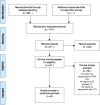The progression rate of peripheral arterial disease in patients with intermittent claudication: a systematic review
- PMID: 31404410
- PMCID: PMC6683562
- DOI: 10.1186/s13047-019-0351-0
The progression rate of peripheral arterial disease in patients with intermittent claudication: a systematic review
Abstract
Background: Intermittent claudication (IC) is the most common symptom of peripheral arterial disease and is generally treated conservatively due to limited prognostic evidence to support early revascularisation in the individual patient. This approach may lead to the possible loss of opportunity of early revascularisation in patients who are more likely to deteriorate to critical limb ischaemia. The aim of this review is to evaluate the available literature related to the progression rate of symptomatic peripheral arterial disease.
Methods: We conducted a systematic review of the literature in PubMed and MEDLINE, Cochrane library, Elsevier, Web of Science, CINAHL and Opengrey using relevant search terms to identify the progression rate of peripheral arterial disease in patients with claudication. Outcomes of interest were progression rate in terms of haemodynamic measurement and time to development of adverse outcomes. Two independent reviewers determined study eligibility and extracted descriptive, methodologic, and outcome data. Quality of evidence was evaluated using the Cochrane recommendations for assessing risk of bias and was reported according to the Preferred Reporting Items for Systematic Reviews and Meta-Analyses guidelines.
Results: Seven prospective cohort studies and one retrospective cohort study were identified and included in this review with the number of participants in each study ranging from 38 to 1244. Progression rate reports varied from a yearly decrease of 0.01 in ankle-brachial pressure index (ABPI) to a yearly decrease ABPI of 0.014 in 21% of participants. Quality of evidence ranged from low to moderate mostly due to limited allocation concealment at recruitment and survival selection bias.
Conclusions: Progression of PAD in IC patients is probably underestimated in the literature due to study design issues. Predicting which patients with claudication are likely to deteriorate to critical limb ischaemia is difficult since there is a lack of evidence related to lower limb prognosis. Further research is required to enable early identification of patients at high risk of progressing to critical ischaemia and appropriate early revascularisation to reduce lower limb morbidity.
Keywords: Haemodynamic deterioration; Intermittent claudication; Peripheral arterial disease; Prognosis; Progression.
Conflict of interest statement
Competing interestsProf Catherine Bowen is the Editor in Chief (UK) of the Journal of Foot and Ankle Research. It is journal policy that editors are removed from the peer review and editorial decision-making processes for papers they have co-authored. The remaining authors declare no conflicts of interest in relation to this work.
Figures
References
-
- McDermott MM, Liu K, Greenland P, Guralnik JM, Criqui MH, Chan C, et al. Functional decline in peripheral arterial disease: associations with the ankle brachial index and leg symptoms. JAMA. 2004;292(4):453–461. - PubMed
-
- Regensteiner JG, Hiatt WR, Coll JR, Criqui MH, Treat-Jacobson D, McDermott MM, et al. The impact of peripheral arterial disease on health-related quality of life in the peripheral arterial disease awareness, risk, and treatment: new resources for survival (PARTNERS) program. Vasc Med. 2008;13(1):15–24. - PubMed
-
- Fowkes FGR, Rudan D, Rudan I, Aboyans V, Denenberg JO, McDermott MM, et al. Comparison of global estimates of prevalence and risk factors for peripheral artery disease in 2000 and 2010: a systematic review and analysis. Lancet. 2013;382(9901):1329–1340. - PubMed
-
- Sartipy F, Sigvant B, Lundin F, Wahlberg E. Ten year mortality in different peripheral arterial disease stages: a population based observational study on outcome. Eur J Vasc Endovasc Surg. 2018;55(4):529–536. - PubMed
Publication types
MeSH terms
Grants and funding
LinkOut - more resources
Full Text Sources
Medical


